Keywords
|
| Cloud negotiation, Resource allocation, Multi-issue negotiation, Negotiation agent |
INTRODUCTION
|
| A cloud is a collection of interconnected system, the user can use the resources and pay for that services. In cloud the provider and the consumer have done a negotiation through service-level agreement. QoS is negotiated among two [2] parties for the specific negotiation protocols and is recorded by Service Level Agreements (SLAs) standard. Users require various commitment and assurance on the top of allocated resources to carry out a job along with for dealing through invalid condition. These terms have to be established upon by use and manifested in formation of SLA. A service-level agreement is a negotiated agreement among two parties, where one is the consumer and the other is the service provider. This can be an officially required formal or an informal "contract”. In this paper the SLA is defines a set of quality of service (QoS) constraints such as price, time and task and specifies how the services are accessed by consumer through negotiation. To objective of this work: 1) performs negotiation on task as per the time and price of the service;2) for characterizing the time slot preferences;3) to design a tradeoff algorithms for the negotiation strategy of consumers and the providers. In this paper the cloud architecture is needed for storing a consumer’s data in cloud through negotiation. The provider provides the needs for storage according to provider condition satisfaction based on the consumer’s request. A SLA is a agreement among participating parties which acts as a authorized document for a set of warranty and QoS metrics. These papers propose service level agreement using advance reservation based resource negotiation which improves not just throughput but also make best use of the utilization of resources. |
| A. Negotiation Agent Mechanism |
| The negotiation process involve between the consumer and the provider. Provider is responsible for advertising a service and consumer discovers the services. Simulations are done periodically. Negotiator manages Service Level Agreement (SLA).The provider and the consumer extreme on time, price, and task such as contest and prospect. Negotiation protocol for the negotiation mechanism evaluates offers awaiting both agreements will be reached. The advantages of SLA are automated agreement creation, Ensure QoS for services for cloud consumer, Identify expectations, clarify responsibilities and make communication between a service provider and consumer. |
| B. Automatic Negotiation |
| The automatic negotiation mechanism is established for the problem of dynamic resource allocation. Multiple providers and consumers agents are negotiating parallel with each other via paying price an agent can decommit from the agreement. Here provider and consumer negotiate resource rental associates automatically. Each provider has different variety of resources. Here simply a single set of resources is acceptable for every task. By analyzing negotiation, the consumer estimate provider’s cost and market competition [1]. |
RELATED WORK
|
| Negotiation based on Service Level Agreement (SLA) is an agreement among providers and consumers. All resources are borrowed using cloud computing along with utility computing but in cloud computing [2] the company has fewer facts regarding resource of the services. In negotiation mechanism, the consumer and the provider can negotiate over both contract price and commitment. |
| A negotiation method for flexible price of Cloud resources, providers can gain from more efficient consumption of their resources, and consumers can gain from cost reduction in several situations and having [4] more flexibility in scheduling the start and execution times for running their applications. |
| For accessing cloud resources, the consumer and the provider making deals within the cloud computing environment. Identifying an agreement among the consumer and the provider to address the loss, the agreement specifying atleast a [4] minimum service requirements. |
| Exchanging the resources at a service level atleast equal to the minimum service level and for a price does not exceed the maximum price specified in the agreement and identify the comprising agreement database for an agreement through negotiation by the provider. Toward scheduling a task to an adaptable resources for a negotiation in accord [3] with adaptable time, which involves finding out an appropriate order which all the tasks can be executed such that execution time and execution cost can be minimized. |
| A negotiation mechanism provides a means for consumers to begin contracts with providers to assurance that consumers can run their applications at the reserved time slots without interval. Besides, the negotiation method should also permit both providers and consumers to specify their preferences. |
| For example, providers may charge a higher price for as long as services at peak time and a lower price at nonpeak time, and consumers may want to pay a higher (correspondingly, lower) price to use a service at more (correspondingly, less) desirable time slots. In this work, a price and time slot technique so as to enables both providers and customers to do the following: 1) specify their preference on behalf of price and time slot and 2) search for mutually suitable prices and time slots. |
| The provider and the consumer attaining a resource in cloud through: |
| A. Negotiation Objectives |
| The negotiation objective is not just price but as well further essentials such as quality, reliability of supply, or the creation of long-term relationships. To considering multiple objectives include cost, refresh time, process time and availability. The major objectives for a consumer, a SaaS negotiator and a provider are: |
| Consumer: To reduce price along with assured QoS within estimated timeline. |
| SaaS Broker: To maximize profit from the edge between the consumer’s resources and the providers’ negotiated price. |
| SaaS Provider: To make the most of profit by accepting as various requests as likely to extend market share. |
| B. QoS Parameters |
| QoS parameters are to: fill the services request in sort to negotiate the Cloud resource; describe the Cloud offer; match the compliant services and build the best available solution; define the SLA; monitor the service levels. |
| C. SLA Negotiation |
| These SLA negotiation among multiple Cloud providers will be delegate to a broker in a market based context that provide: For searching for obtainable Cloud services, compliant with user needs; Finding trustiness of providers; Deciding among whom to negotiate, according to user requirements; Negotiating the finest price for the same propose by different providers; negotiating of several SLAs, among [6] different providers, to overcome the need of one compliant propose by a single provider. |
| D. Multilateral Negotiation Protocol |
| The Cloud negotiation procedure for specify the negotiation concert among consumer and provider is specified as follows: [7] Negotiation takings in a sequence of rounds; |
| • Consumer and provider negotiate by making proposals in alternate rounds and multiple consumer-provider pairs can negotiate deals concurrently. |
| • When a negotiator makes a scheme, it proposes an agreement from its space of feasible deals and If no agreement is reached, negotiation takings to the subsequently round. |
| • Negotiation among the consumer and the provider they terminate: while an agreement is reached, or with an inconsistency when one of the negotiation deadline is reached. |
EXISTING SYSTEM
|
| In existing system, the negotiation is done only based on price and time. There is a concession for the frequent consumers. The providers allocate storage according to the negotiation of price and time and the amount of task performed by the consumer. |
| A. Price And Time Slot Negotiation |
| An agent based cloud test bed performs as a market for cloud. Both the consumer and provider agent take part in cloud negotiation throughout the cloud market registry. The registry is an information repository. Provider agent purpose as service advertiser and consumer agent discovers the services from environment. Service discovery afford in test bed during the message passing. Periodic simulation restricted by the simulation controller. |
| Cloud status recorder shows the information regarding the cloud market and negotiation as of all negotiation round. Two algorithm named tradeoff algorithm and concession making algorithm be implemented for PTN. Cloud reservation is task in memory array. Here particular issue and multi issue negotiation is considered [4]. Consider further negotiation issues for quality of services (QoS). |
| Introduce coordinators which allocate the application across different data centers which enabling SLA’s for improving application’s performance, consistency and scalability. Provisioning of virtual machine suggest protection. PTN method follows the negotiation protocol is agent construct negotiation in alternate rounds. It will recognize when both the consumer agent and provider agent reached in a contract for price and time. The negotiation fails when one of agent’s deadlines expires by reach the agreement. |
| Algorithm used in proposed system is the tradeoff algorithm and the concession making algorithm for price and time slot negotiation. The tradeoff algorithm involving for generating a negotiation based on the time of the service and the price of the service which is performing by the consumer for cloud resources. The concession making algorithm is based on the available frequent consumers performing the cloud resource according to the negotiation conditions of producer. |
| 1) Price Utility task |
| While consumers prefer the cheapest price for leasing a service, providers desire to trade their services at the peak prices. Let IPC and RPC be the mainly prefer price and the least prefer price of a consumer agent. Let P be a price that both agents accomplish a contract. For a consumer, the price utility UC P (P) for P is specified as, |
 |
| For a provider, the price utility UPP (P) is |
 |
| 2) Consumer’s time-slot utility task |
| When reserving a Cloud service, a consumer usually describes different preferences for various sets of time slots. The time-slot utility purpose of a consumer consists of fractional functions for different time slots. A consumer can choose various reference points. Every reference point Txm is assign a utility value Uxm to be the time-slot preference. A reference point is used to generate the xth th partial function of the time-slot utility function. Each time slot is related with a utility value, and the time-slot utility ideals are assigned among uTmin.’’ |
 |
| 3) Provider’s time-slot utility task |
| Providers may desire to allocate jobs: 1) to time slots where a low service require is estimated (when there are various concurrent needs, it is harder to schedule jobs as of partial resource capacities); 2) to the initial available time slots (since computing resources devaluate among time, idle resources guide to loss of revenues for the providers); and 3) to the time slots at which the job sizes can be accommodate to optimize keep consumption. |
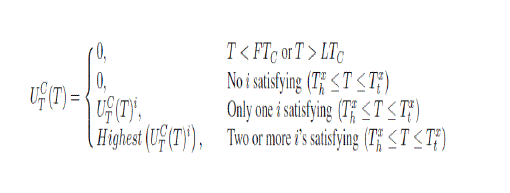 |
| B. Disadvantage |
| There is no task negotiation, since there is no limit for the storage of the tasks done by the consumer, the provider is supposed to store all the tasks that are done by the consumer. |
PROPOSED SYSTEM
|
| In the proposed system, the consumer makes an agreement with the provider through negotiation for accessing cloud storage. There are 3 parameters for making this negotiation: price, time and task. The provider concurrently performs a multiple proposal to make individual time, price slot and task negotiation for each consumer. |
| A negotiation is the process of performing the things through deals among two parties to reach their goals as per their needs. Both the consumer and the provider agents achieve the best performance in terms of negotiation. The consumer and the provider gain a mutually satisfying agreement on negotiation of price, time and the task. |
| On one occasion the negotiation has concluded and if mutually the both consumer and the provider are agree to the terms, and then they have to sign an agreement and the consumer should follow the producer terms and conditions for cloud resources through negotiation. |
| Two things are going to enhance for a task negotiation in cloud: They are; |
| 1) Consumer job allocation process |
| 2) Producer allocating resources and storing their task according to their conditions for consumer and as per the consumer request through database. |
| A. Architecture Diagram |
| The proposed architecture diagram involves; |
| • The consumer’s needs to store their task or job in cloud on agreement through negotiation with providers. Those on agreements through negotiation are based on the execution time and price of a service and an amount of a task. |
| • So for that negotiation the consumer performing a job allocation process by submitting and selecting the job and those selected jobs are stored in the database. |
| • Producer prepare to place an agreement with consumer for storage through negotiation and delegating the terms and conditions for an agreement through negotiation for consumer. |
| • The QoS monitoring the producer conditions with consumer task which are stored in database for an agreement through negotiation. Based on that agreement the consumer stores their jobs in cloud. |
| B. Algorithm |
| The proposed algorithm is mainly based on the Task Based Meta Negotiation. Metanegotiation is defined in way of a meta-negotiation document where participating parties may convey: the pre-requisites to be fulfilled for a negotiation. In Metanegotiation, anywhere participating parties can specify negotiation necessities and based on a private selection approach select those services which assure successful negotiation. In this approach, the participating parties bring out only the set of rules and conditions whereas keeping negotiation strategies hidden from potential associates. Meta-negotiation approach agrees to two parties to attain an agreement on what negotiation protocols and documents to utilize by initiating the negotiation process. |
| 1) The task based meta-negotiation process enabling: |
| Publishing |
| A service provider, publishing the descriptions and conditions for task negotiation Service consumers perform the negotiation on tasks, time and price. |
| Lookup |
| Lookup which task taken to be negotiation by the consumer and the providers. |
| Task Based Meta Negotiation Matching |
| The QoS monitors the consumer data and combine these data into QoS metrics for the path. Based on this monitoring process the service provider who is exactly matching with the negotiation processes of the consumer will be selected |
| Negotiation Process |
| At last, after a suitable service provider and a negotiation procedure is preferred by a consumer by using his/her private selection strategy, the negotiations between them will start according to the conditions specified in the provider’s document. |
| C. Negotiation State Machine |
| The broker keeps way of the negotiation process through a state machine. The transition among the states is lead by the broker’s strategy and the responses from the provider. The different states for a task negotiation are: |
| • Initiation for negotiation |
| • Submit proposal |
| • Counter |
| • Accept proposal |
| • Confirm proposal |
| • Reject proposal |
|
|
| The broker make a plan and chooses one out of a list of resource providers based on factors such as resource price, time and the task of the consumer. |
| • To initiate a negotiation session and submit the proposal and if the proposal is accepted directly, then a proof message is returned to the provider. |
| • If a counter proposal is established, then it is evaluated to make out whether the counter reservation is still in the deadline. If so, then it is accepted by the broker. If not, then the aggression factor is improved to decrease the number of nodes essential. |
| • This made on the assumption that needs for smaller number of nodes have better chances to be accepted or found more acceptable counter time slots. This carry on until the aggression aspect is increased upto 1 which the most range available to broker. |
| • If the counter proposal from the resource provider does not assure the deadline requirements, the proposal is rejected and the session stopped. |
EXPECTED OUTCOMES
|
| The expected outcomes of the task negotiation with price and time slot negotiation using Meta Task Negotiation are: |
| The Perforrmance Analysing chart between cloud memory and the job id for task negotiation is: |
CONCLUSION
|
| In this work, the negotiation is done based on all the parameters such as task, time and price of the services. The additional parameter task negotiation improves the QoS and throughput for the cloud resources. This additional parameter task is to decreasing the burden, any problem in execution of consumer task, unused memory or any loss of resource of the consumer and the producer during negotiation process among through price, time and the amount of task. |
| |
Figures at a glance
|
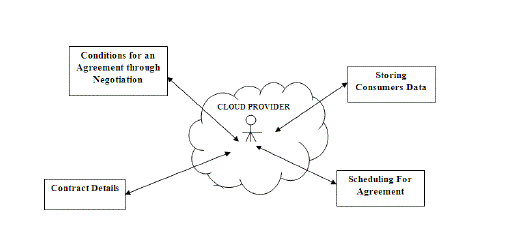 |
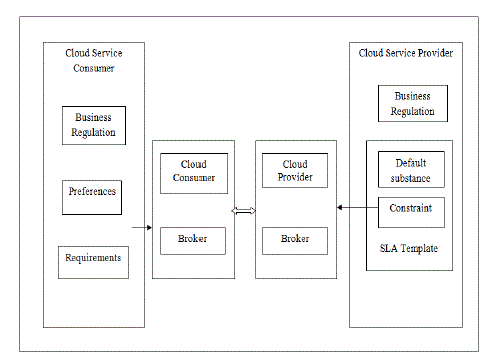 |
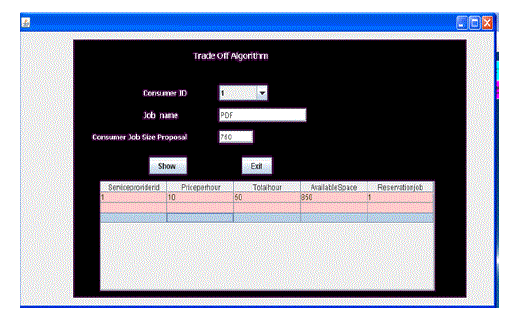 |
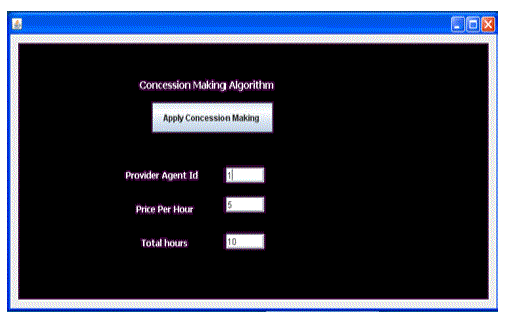 |
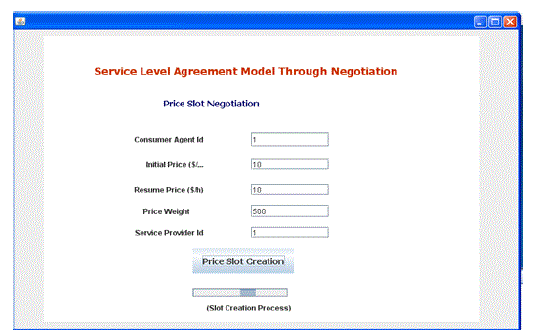 |
| Figure 1 |
Figure 2 |
Figure 3 |
Figure 4 |
Figure 5 |
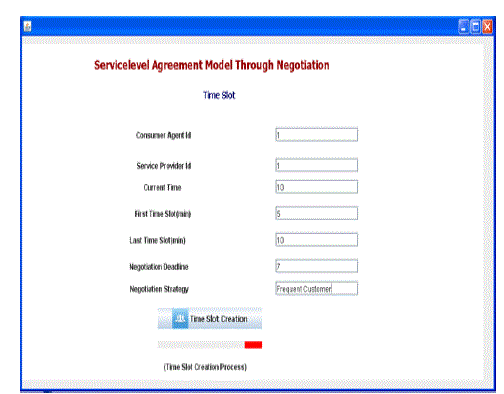 |
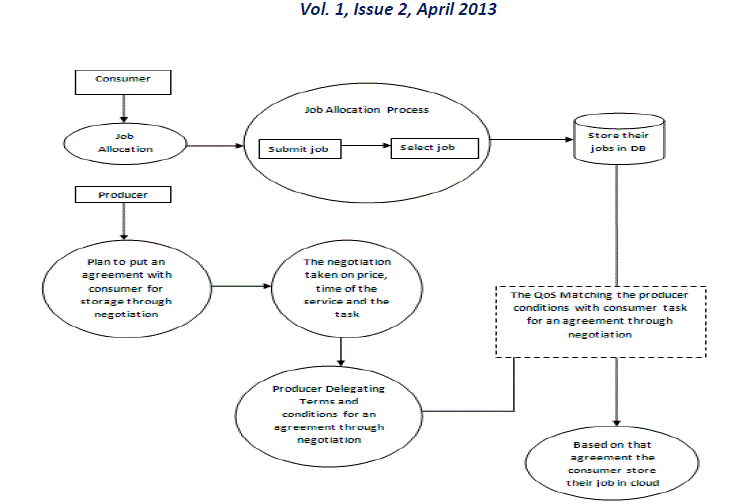 |
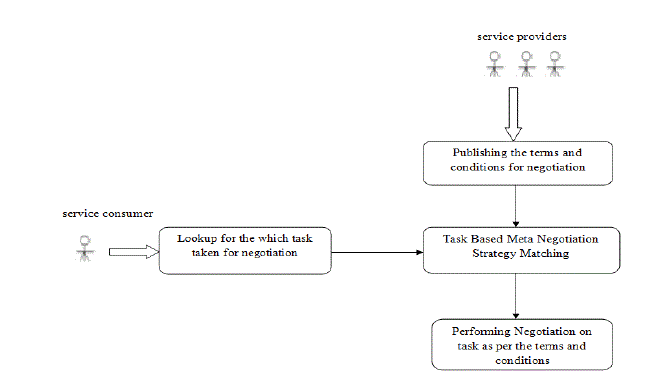 |
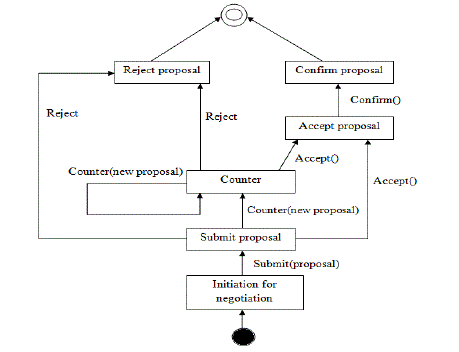 |
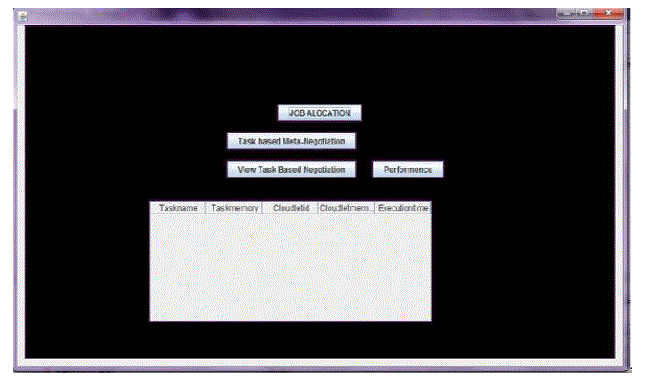 |
| Figure 6 |
Figure 7 |
Figure 8 |
Figure 9 |
Figure 10 |
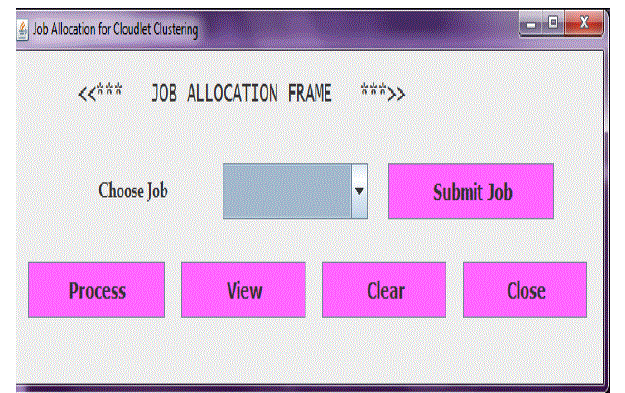 |
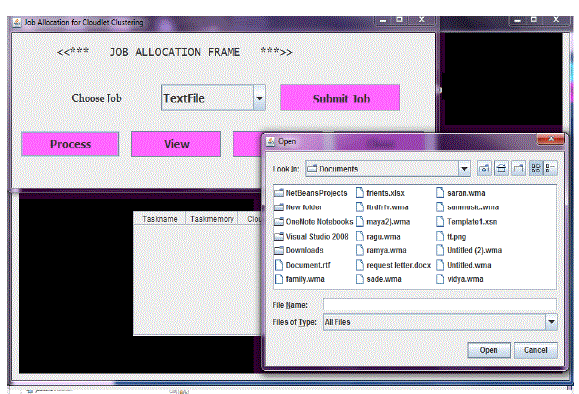 |
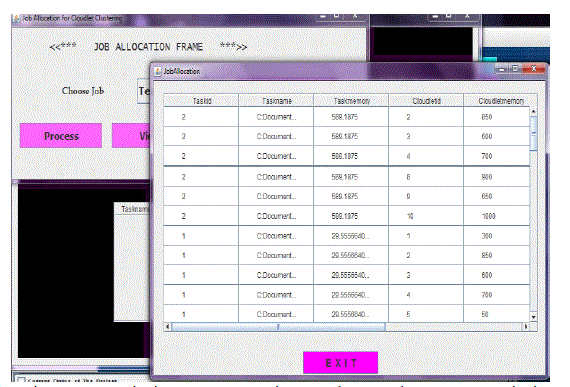 |
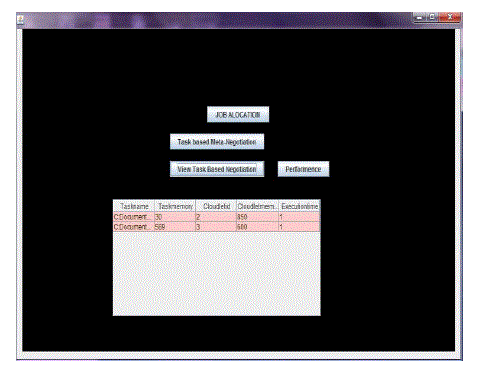 |
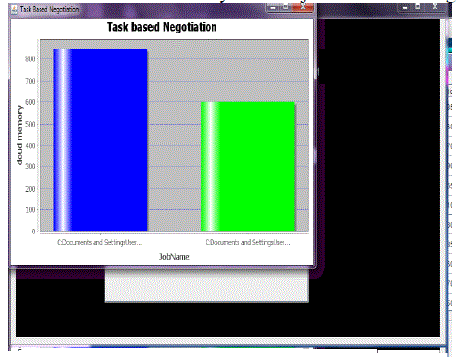 |
| Figure 11 |
Figure 12 |
Figure 13 |
Figure 14 |
Figure 15 |
|
| |
References
|
- Bo An, Victor Lesser, David Irwin, Michael Zink “Automated Negotiation with Decommitment for Dynamic Resource Allocation in Cloud Computing” , Proc. of 9th Int. Conf. on Autonomous Agents and Multiagent System, May, 10–14, 2010
- Divya Jyothi “Ecommerce Dealer Agent Mechanism in Cloud Computing Environment” International Journal of Advanced Research in Computer Science and Electronics Engineering Volume 1, Issue 4, June 2012
- Gaurav Raj, Ankit Nischal “Efficient Resource Allocation in Resource provisioning policies over Resource Cloud Communication Paradigm” ICCSA,Vol.2, No.3, June 2012
- Seokho Son and Kwang Mong Sim “A Price- and-Time-Slot- Negotiation Mechanism for Cloud Service Reservations”, IEEE Transactions On Systems, Man, & Cybernetics—Part B: Cybernetics, Vol. 42, No. 3, June 2012.
- Shaminder Kaur and Amandeep Verma, “An Efficient Approach to Genetic Algorithm for Task Scheduling in Cloud Computing Environment”, I.J. Information Technology and Computer Science, 2012, 10, 74-79 Published Online September 2012 in MECS,DOI: 10.5815/ijitcs.2012.10.09
- Salvatore Venticinque “Agent Based Services for Negotiation, Monitoring and Reconfiguration of Cloud Resources”, Second University of Naples, Italy.
- Kwang Mong Sim, IEEE Senior Member “Towards a Unifying Multilateral Cloud Negotiation Strategy”, Proceedings of the International MultiConference of Engineers and Computer Scientists 2013 Vol I, IMECS 2013, March 13 - 15, 2013, Hong Kong.
|